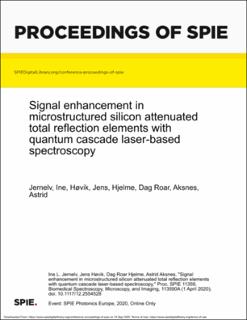| dc.contributor.author | Jernelv, Ine Larsen | |
| dc.contributor.author | Høvik, Jens | |
| dc.contributor.author | Hjelme, Dag Roar | |
| dc.contributor.author | Aksnes, Astrid | |
| dc.date.accessioned | 2020-09-16T07:46:05Z | |
| dc.date.available | 2020-09-16T07:46:05Z | |
| dc.date.created | 2020-07-07T13:12:31Z | |
| dc.date.issued | 2020 | |
| dc.identifier.issn | 0277-786X | |
| dc.identifier.uri | https://hdl.handle.net/11250/2677973 | |
| dc.description.abstract | Sensors in mid-infrared spectroscopy based on attenuated total reflection (ATR) sensing with internal reflection elements (IREs) facilitate easier measurements of aqueous solutions or other opaque analytes. Micromachined silicon (Si) elements are an attractive alternative to conventional IREs, as they can be produced cheaply with silicon processing. Techniques for surface modifications are also easily integrated into the wafer process, and surface structures such as micropillars or nanoparticles can thereby be used for signal enhancement. Replacing the classic Fourier transform infrared (FTIR) spectrometers with tuneable quantum cascade lasers (QCLs) also opens up new avenues for sensing. In this study, the performance of basic and signal-enhanced Si IREs has been compared for measurements in a spectroscopy setup with a fibre-coupled tuneable QCL source. These IREs had V-shaped microgrooves etched on the underside for more efficient in-coupling of light, while the signal enhanced IREs also had micropillars on the top surface. The results are also contrasted with measurements done in a standard ATR-FTIR spectrometer, using an Alpha II spectrometer with a single-reflection diamond ATR crystal. Various concentrations of glucose (0-5000 mg/dl) in aqueous solutions were used to characterise the system performance. The quality of the signal enhancement was evaluated with regard to sensitivity and noise level in the acquired spectra. The microstructured Si IREs gave a signal enhancement of up to a factor of 3.8 compared to a basic Si element, with some concomitant increase in noise. The absorbance was higher for both types of Si IREs as compared to the diamond ATR crystal. The effective enhancement and the limit of quantification improved by a factor up to 3.1 in the signal-enhanced IREs compared to the basic Si element. | en_US |
| dc.language.iso | eng | en_US |
| dc.publisher | Society of Photo-optical Instrumentation Engineers (SPIE) | en_US |
| dc.title | Signal enhancement in microstructured silicon attenuated total reflection elements with quantum cascade laser-based spectroscopy | en_US |
| dc.type | Peer reviewed | en_US |
| dc.type | Journal article | en_US |
| dc.description.version | publishedVersion | en_US |
| dc.source.journal | Proceedings of SPIE, the International Society for Optical Engineering | en_US |
| dc.identifier.doi | 10.1117/12.2554528 | |
| dc.identifier.cristin | 1818828 | |
| dc.relation.project | Norges forskningsråd: 248810 | en_US |
| dc.relation.project | Norges forskningsråd: 248872 | en_US |
| dc.description.localcode | © 2020 Society of Photo Optical Instrumentation Engineers. One print or electronic copy may be made for personal use only. Systematic reproduction and distribution, duplication of any material in this paper for a fee or for commercial purposes, or modification of the content of the paper are prohibited | |
| cristin.ispublished | true | |
| cristin.fulltext | postprint | |
| cristin.qualitycode | 1 | |
